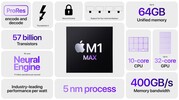Apple M1 Max vs Apple M3 Pro 11-Core
Apple M1 Max
► remove from comparison
The Apple M1 Max is a System on a Chip (SoC) from Apple that is found in the late 2021 MacBook Pro 14 and 16-inch models. It offers all 10 cores available in the chip divided in eight performance cores (P-cores with 600 - 3220 MHz) and two power-efficiency cores (E-cores with 600 - 2064 MHz). There is no Turbo Boost for single cores or short burst periods. The cores are similar to the cores in the Apple M1.
The big cores (codename Firestorm) offer 192 KB instruction cache, 128 KB data cache, and 24 MB shared L2 cache (up from 12 MB in the M1). The four efficiency cores (codename Icestorm) are a lot smaller and offer only 128 KB instruction cache, 64 KB data cache, and 4 MB shared cache. CPU and GPU can both use the 48 MB SLC (System Level Cache). The efficiency cores (E cluster) clock with 600 - 2064 MHz, the performance cores (P cluster) with 600 - 3228 MHz.
The unified memory (32 or 64 GB LPDDR5-6400) next to the chip is connected by a 512 bit memory controller (200 GB/s bandwidth) and can be used by the GPU and CPU. This is the main difference to the M1 Pro and the CPU performance is quite similar.
The biggest difference to the M1 Pro is the bigger integrated GPU with 24 or 32 cores (up from 16).
Furthermore, the SoC integrates a fast 16 core neural engine, a secure enclave (e.g., for encryption), a unified memory architecture, Thunderbolt 4 controller, an ISP, and media de- and encoders (including two ProRes engines).
The M1 Pro is manufactured in 5 nm at TSMC and integrates 57 billion transistors. The peak power consumption of the chip was advertised around 30W for CPU intensive tasks.
Apple M3 Pro 11-Core
► remove from comparison
The Apple M3 Pro 11 Core is a system on a chip (SoC) from Apple for notebooks that was introduced late 2023. It integrates 11 of the 12 CPU cores with 5 of 6 performance cores with up to 4.06 GHz and 6 efficiency cores with 2.8 GHz.
Compared to the M2 Pro the M3 Pro has been slimmed down somewhat and swaps two performance cores for efficiency cores. This is due to the changed core configuration, as 6 cores are now used per cluster (the M2 Pro and M3 still have 4 cores per cluster). Furthermore, the memory bus has been reduced from 256 bits to 192 bits (150 GB/s vs. 200 GB/s). Thanks to the new architecture and higher clock rates, the new M3 Pro is still slightly faster.
The M3 Pro also integrates a new graphics card with dynamic caching, mesh shading and ray tracing acceleration via hardware. In the entry-level model, only 14 of the chip's 18 cores are used and support up to 3 displays simultaneously (internal and 2 external).
GPU and CPU can jointly access the shared memory on the package (unified memory). This is available in 18 or 36 GB variants and offers 150 GB/s maximum bandwidth (192 bit bus).
The integrated 16-core Neural Engine has also been revised and now offers 18 TOPS peak performance (compared to 15.8 TOPS in the M2 but 35 TOPS in the new A17 Pro). The video engine now also supports AV1 decoding in hardware. H.264, HEVC and ProRes (RAW) can still be decoded and encoded.
Unfortunately, the integrated WLAN only continues to support WiFi 6E (no WiFi 7), unlike the small M3 SoC thunderbolt 4 is also supported (max 40 Gbit/s).
The chip is manufactured in the current 3nm process (N3B) at TSMC and contains 37 billion transistors (-7.5% vs. Apple M2 Pro).
| Model | Apple M1 Max | Apple M3 Pro 11-Core | ||||||||||||||||||||||||||||||||||||
| Series | Apple M1 | Apple M3 | ||||||||||||||||||||||||||||||||||||
| Series: M3 |
|
| ||||||||||||||||||||||||||||||||||||
| Clock | 2060 - 3220 MHz | 2748 - 4056 MHz | ||||||||||||||||||||||||||||||||||||
| L1 Cache | 2.9 MB | |||||||||||||||||||||||||||||||||||||
| L2 Cache | 28 MB | |||||||||||||||||||||||||||||||||||||
| L3 Cache | 48 MB | |||||||||||||||||||||||||||||||||||||
| Cores / Threads | 10 / 10 | 11 / 11 5 x 4.1 GHz Apple M3 P-Core 6 x 2.7 GHz Apple M3 E-Core | ||||||||||||||||||||||||||||||||||||
| Transistors | 57000 Million | 37000 Million | ||||||||||||||||||||||||||||||||||||
| Technology | 5 nm | 3 nm | ||||||||||||||||||||||||||||||||||||
| Features | ARMv8 Instruction Set | ARMv8 Instruction Set | ||||||||||||||||||||||||||||||||||||
| iGPU | Apple M1 Max 32-Core GPU | Apple M3 Pro 14-Core GPU | ||||||||||||||||||||||||||||||||||||
| Architecture | ARM | ARM | ||||||||||||||||||||||||||||||||||||
| Announced | ||||||||||||||||||||||||||||||||||||||
| TDP | 27 Watt | |||||||||||||||||||||||||||||||||||||
| Manufacturer | www.apple.com |
Benchmarks
Average Benchmarks Apple M1 Max → 100% n=15
Average Benchmarks Apple M3 Pro 11-Core → 119% n=15
* Smaller numbers mean a higher performance
1 This benchmark is not used for the average calculation













